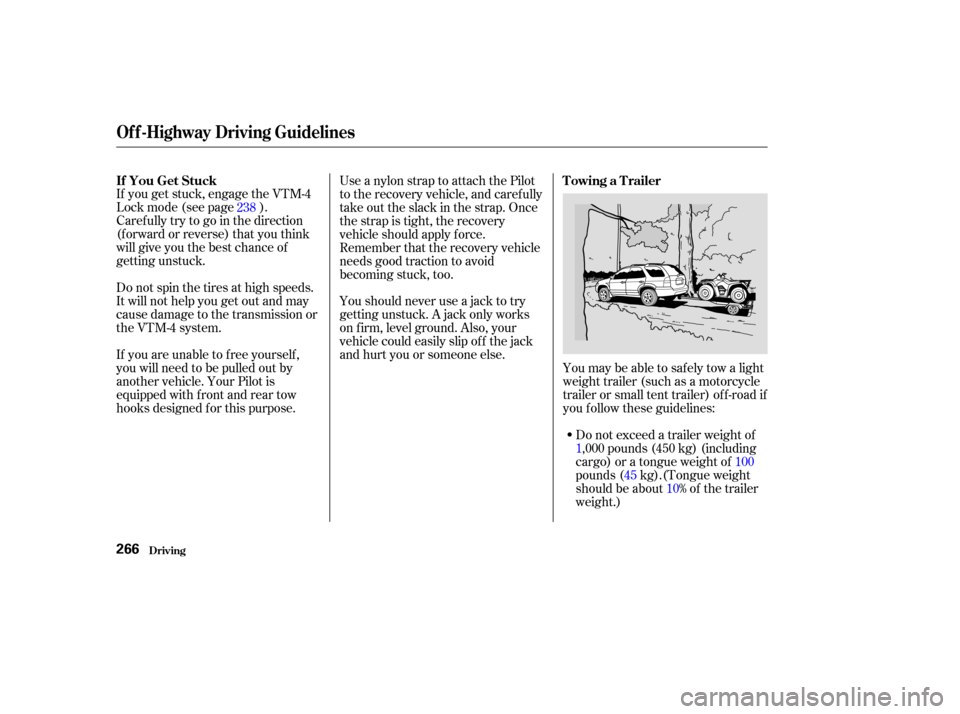Page 256 of 392
Check the gross combined weight. Check the weight of the hitchedtrailer. Write this number down.Check the weight of the unhitched
trailer. Limit: See page .
Calculate the tongue load.
Subtract the weight in Step 5 f rom
the weight in step 6.
Limit: See page .
Range: 5-10% f or boat trailers
8-15% f or other trailers
Gross combined weight should be
decreased 2% f or every 1000 f eet
(305 meters) of elevation.
4.
5.6.
7.
Limit:
249
249
Towing a Trailer
Driving252
9700 lbs (4410 kg)
Page 257 of 392

Discuss any additional needs with
your trailer sales or rental agency,
and make sure all equipment is
properly installed and maintained.
Since local requirements may vary,
check with appropriate state
authorities to be sure that your
equipment will meet all regulations
in the areas where you plan to tow.Always use saf ety chains when you
tow a trailer. Make sure the chains
are secured to the trailer and hitch,
and that they cross under the tongue
so they can catch the trailer if it
becomes unhitched. Leave enough
slack to allow the trailer to turn
corners easily, but to do not let the
chains drag on the ground.This device is recommended if your
trailer tends to sway. Your trailer
maker can tell you what kind of sway
control you need and how to install it.
Towing generally requires a variety
of supplemental equipment. To
ensure the best quality, we
recommend that you purchase
Honda equipment whenever possible.
Your dealer of f ers a trailer package
that includes a hitch, a ball mount, a
wiring harness, a transmission f luid
cooler, and a heavy-duty power
steering f luid cooler. We strongly recommend that you
have your Honda dealer install a
genuine Honda hitch and the
required f luid coolers. Using non-
Honda equipment may result in
serious damage to your vehicle.
A weight distributing hitch is not
recommended f or use with your Pilot
as an improperly adjusted weight
distributing hitch may reduce
handling stability and braking
perf ormance.
To help prevent overheating, a
heavy-duty transmission f luid cooler
and a heavy-duty power steering
f luid cooler are required f or trailer
towing. These coolers are available
only f rom your Honda dealer.
CONT INUED
T owing Equipment and
A ccessoriesHitch
Weight Distributing HitchSaf et y Chains Sway Cont rol
T ransmission Fluid Cooler andPower St eering Fluid Cooler
Towing a Trailer
Driving253
Page 258 of 392
There are two common types of
trailer brakes: surge and electric.
Surge brakes are common f or boat
trailers, since the brakes will get wet.
Electric brakes must be
electronically actuated. Do not
attempt to tap into your vehicle’s
hydraulic system. Any attempt to
attach trailer brakes to your vehicle’s
hydraulic system will lower braking
ef f ectiveness and create a potential
hazard. Honda requires that any trailer with
a total trailer weight of 1000 lbs (455
kg) or more have its own brakes.
See your brake manuf acturer f or
more inf ormation on installing
electric brakes.
Trailer Brakes
Towing a Trailer
Driving254
Page 260 of 392

Many states and provinces require
special exterior mirrors when towing
a trailer. Even if they don’t, you
should install special mirrors if you
cannot clearly see behind you, or if
the trailer creates a blind spot.
We also recommend that you carry a
f ull-size spare wheel and tire f or your
trailer. Ask your trailer sales or
rental agency where and how to
store the spare. See page f or proper tire size,
page f or how to store a f ull-sized
wheel and tire, and page for
inf ormation on changing a f lat tire.
Remember to unhitch the trailer
bef ore changing a f lat.When preparing to tow, and bef ore
driving away, be sure to check the
f ollowing:
The vehicle has been properly
serviced, and the brakes,
suspension, and cooling system
are in good operating condition. If
you tow f requently, f ollow the
Severe Conditions maintenance
schedule. The lights and brakes on your
vehicle and the trailer are working
properly.
Your vehicle tires and spare are in
good condition and properly
inf lated (see page ).
The trailer tires and spare are in
good condition and inf lated as
recommended by the trailer
maker.
When towing a trailer, we
recommend that you carry a f ull-size
spare wheel and tire f or your vehicle.
Using the compact spare that came
with the Pilot may adversely affect
vehicle handling.
Allitemsonandinthetrailerare
properly secured and cannot shif t
while you drive. Thehitch,safetychains,andany
other attachments are secure. All weights and loads are within
limits (see pages and ). The trailer has been properly
serviced and is in good condition.Towing perf ormance can be
af f ected by high altitude, high
temperature, or climbing steep
grades. Theref ore, premium
f uel is recommended when
towing more than 3,500 lbs
(1,590 kg).
313
340 335 308
247 249
Trailer Mirrors Spare TiresPre-T ow Checklist
Towing a Trailer
Driving256
Page 261 of 392

The added weight, length, and
height of a trailer will af f ect your
vehicle’s handling and perf ormance,
so driving with a trailer requires
some special driving skills and
techniques.
Foryoursafetyandthesafetyof
others,taketimetopracticedriving
maneuvers bef ore heading f or the
open road, and f ollow the guidelines
discussed below.
Avoid towing a trailer during your
vehicle’s f irst 500 miles (800
kilometers) (see page ).Drive slower than normal in all
driving situations. Obey all local
speed limits f or vehicles with trailers.
To keep the transmission f rom
f requently upshif ting and
downshif ting, drive in D. When
driving with a f ix-sided (e.g, camper,
utility) trailer, do not exceed 55 mph
(88 km/h). At higher speeds, the
trailer may sway or affect vehicle
handling.
Maketurnsmoreslowlyandwider
than normal. The trailer tracks a
smaller arc than your vehicle, and it
canhitorrunoversomethingthe
vehicle misses. Allow more time and
distance f or braking. When you need
to slow down, slowly lif t your f oot of f
the throttle and gradually apply the
brakes. Do not brake or turn
suddenly as this could cause the
trailer to jackknif e or turn over.
216
CONT INUED
Driving Saf ely With a T railer
Break-In Period T owing Speed
Making T urns and Braking
Towing a Trailer
Driving257
Page 270 of 392

If you get stuck, engage the VTM-4
Lock mode (see page ).
Caref ully try to go in the direction
(f orward or reverse) that you think
will give you the best chance of
getting unstuck.
Donotspinthetiresathighspeeds.
It will not help you get out and may
cause damage to the transmission or
the VTM-4 system.You should never use a jack to try
getting unstuck. A jack only works
on f irm, level ground. Also, your
vehicle could easily slip of f the jack
and hurt you or someone else.
You may be able to saf ely tow a light
weight trailer (such as a motorcycle
trailer or small tent trailer) of f -road if
you f ollow these guidelines:
Do not exceed a trailer weight of
1,000 pounds (450 kg) (including
cargo) or a tongue weight of 100
pounds ( 45kg).(Tongue weight
should be about 10% of the trailer
weight.)
If you are unable to f ree yourself ,
you will need to be pulled out by
another vehicle. Your Pilot is
equipped with f ront and rear tow
hooks designed f or this purpose. Use a nylon strap to attach the Pilot
to the recovery vehicle, and caref ully
take out the slack in the strap. Once
the strap is tight, the recovery
vehicle should apply f orce.
Remember that the recovery vehicle
needs good traction to avoid
becoming stuck, too.
238
If You Get Stuck
T owing a T railer
Of f -Highway Driving Guidelines
Driving266
Page 288 of 392
You may use a synthetic motor oil if
it meets the same requirements
given f or a conventional motor oil: it
displays the API Certif ication Seal,
and it is the proper weight as shown
on the chart. When using synthetic
oil, you must f ollow the oil and f ilter
change intervals given in the
maintenance schedule.
The oil’s viscosity or weight is
provided on the container’s label.
Select the oil f or your vehicle
according to this chart.
5W-20 oil is f ormulated f or year-
round protection of your Honda, to
improve cold weather starting, and
to help your engine use less f uel.
Your Honda does not require any oil
additives. Additives may adversely
af f ect your engine’s or transmission’s
perf ormance and durability.
Engine Oil
Maint enance
Synthetic Oil
A dditives
284
Ambient Temperature
Page 315 of 392

To help increase tire lif e and
distribute wear more evenly, you
should have the tires rotated every
7,500 miles (12,000 km). Move the
tires to the positions shown in the
chart each time they are rotated.
Make sure the installer balances the
wheels when you have new tires
installed. This increases riding
comf ort and tire lif e. Your vehicle’s
original tires were dynamic or ‘‘spin’’
balanced at the f actory. For best
results, have the installer perf orm a
dynamic balance.
In addition to proper inf lation,
correct wheel alignment helps to
decrease tire wear. If you f ind a tire
is worn unevenly, have your dealer
check the wheel alignment.
The tires were properly balanced by
the factory. They may need to be
rebalanced at some time bef ore they
are worn out. Have your dealer
check the tires if you f eel a consis-
tent vibration while driving. A tire
should always be rebalanced if it is
removed f rom the wheel f or repair.
CONT INUED
Tire Rotation
Maintenance
Tires
Maint enance311
Front Front
(For Non-directional
Tires and Wheels) (For Directional
Tires and Wheels)
Improper wheel weights can damage
your vehicle’s aluminum wheels. Use
only genuine Honda wheel weights f or
balancing.